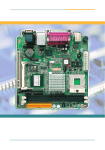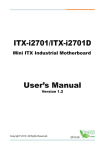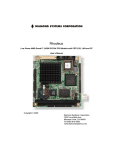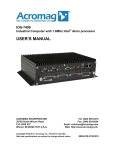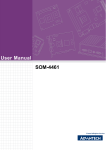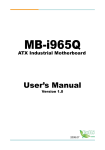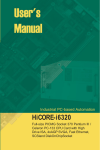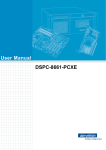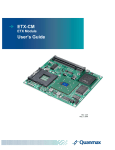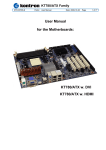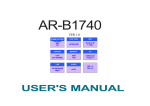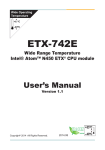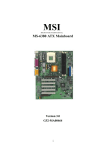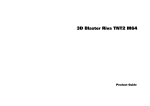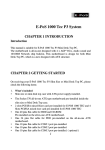Download Untitled
Transcript
ITX-i9453 Mini ITX Industrial Motherboard User’s Manual Version 1.0 2007.08 Index Table of Contents Chapter 1 Introduction ............................................................4 1.1 Copyright Notice ..........................................................................5 1.2 About this User’s Manual ............................................................5 1.3 Warning .......................................................................................5 1.4 Replacing the lithium battery ........................................................6 1.5 Technical Support ........................................................................6 1.6 Warranty ......................................................................................7 1.7 Packing List .................................................................................8 1.8 Ordering Information ....................................................................8 1.9 Specification ................................................................................9 1.10 Board Dimensions ...................................................................10 1.11 Installing the CPU ...................................................................12 1.12 Installing the Memory ..............................................................13 Chapter 2 Installation .............................................................14 Jumpers 2.1 Jumpers and Connectors ..........................................................15 2.2 JBAT1: CMOS Setup .................................................................16 2.3 JP1: CompactFlash Master/ Slave Select ..................................16 2.4 JV1: COM1 Power Source Special Support ...........................16 2.5 JRS1: COM 2 RS-232/422/485 Select .......................................16 2.6 JVLCD1: LCD Panel Voltage Select ...........................................17 2.7 JPWR1: AT/ATX Power Mode Select ..........................................17 Connectors 2.8 IDE1: Primary 40-pin IDE Connector .......................................18 2.9 SATA1/ SATA2: Serial ATA 1, 2 Connector .............................18 2.10 DIO1: Digital I/O Connector ..................................................18 2.11 PCIE1: PCI Express x16 Interface Slot ...............................19 2.12 MINIPCI1: MiniPCI slot ..........................................................19 2.13 JFRT1: Switches and Indicators ............................................19 2.14 INV1: LCD Inverter Connector ...............................................20 2.15 CON1: RS-422/ 485 Connector .............................................20 2.16 USB1/ USB2: USB 2.0 Connector .........................................20 2.17 LPT1: Parallel Port or FDD Connector .................................21 2.18 IR1: Infrared Connector ..........................................................21 2.19 AUDIO1: Audio Interface Port ..............................................22 2.20 COM1: Two D-SUB 9 Connector ...........................................22 2.21 LAN1/ LAN2: 2 x 100/1000 RJ-45 + 4 x USB 2.0 .................23 2.22 VGA1: CRT/DVI Connector ...................................................23 2 ITX-i9453 User’s Manual Index 2.23 2.24 2.25 2.26 2.27 2.28 2.29 KBM1: PS/2 Keyboard & Mouse ...........................................23 LVDS1: LVDS LCD Connector ..............................................24 CFD1: CompactFlash II Socket .............................................24 PW1: ATX Power Supply Connector .....................................25 ATX12V1: 4pin 12V ATX Power Connector ........................25 CPUF1: CPU Fan Power Connector .....................................25 SYSF1: System Fan Power Connector ................................26 Chapter 3 BIOS ......................................................................28 3.1 BIOS Introduction ......................................................................29 3.2 BIOS Setup ...............................................................................29 3.3 Standard CMOS Features .........................................................30 3.4 Advanced BIOS Features .........................................................33 3.5 Advanced Chipset Features ......................................................37 3.6 Integrated Peripherals ...............................................................40 3.7 Power Management Setup ........................................................45 3.8 PNP/PCI Configurations ............................................................49 3.9 PC Health Status .......................................................................51 3.10 Load Optimized Defaults ........................................................52 3.11 Set Password .........................................................................53 3.12 Save & Exit Setup ...................................................................54 3.13 Exit Without Saving .................................................................55 3.14 BIOS Beep Sound core list ......................................................56 3.15 BIOS memory mapping ...........................................................56 3.16 Award BIOS Post Codes ........................................................57 Chapter 4 Appendix ...............................................................62 4.1 I/O Port Address Map ................................................................63 4.2 Interrupt Request Lines (IRQ) ...................................................66 ITX-i9453 User’s Manual 3 Introduction 1 Chapter 1 Introduction 4 ITX-i9453 User’s Manual Introduction 1.1 Copyright Notice All Rights Reserved. The information in this document is subject to change without prior notice in order to improve the reliability, design and function. It does not represent a commitment on the part of the manufacturer. Under no circumstances will the manufacturer be liable for any direct, indirect, special, incidental, or consequential damages arising from the use or inability to use the product or documentation, even if advised of the possibility of such damages. This document contains proprietary information protected by copyright. All rights are reserved. No part of this manual may be reproduced by any mechanical, electronic, or other means in any form without prior written permission of the manufacturer. 1.2 About this User’s Manual This User’s Manual is intended for experienced users and integrators with hardware knowledge of personal computers. If you are not sure about any description in this User’s Manual, please consult your vendor before further handling. 1.3 Warning Single Board Computers and their components contain very delicate Integrated Circuits (IC). To protect the Single Board Computer and its components against damage from static electricity, you should always follow the following precautions when handling it : 1. Disconnect your Single Board Computer from the power source when you want to work on the inside 2. Hold the board by the edges and try not to touch the IC chips, leads or circuitry 3. Use a grounded wrist strap when handling computer components. 4. Place components on a grounded antistatic pad or on the bag that came with the Single Board Computer, whenever components are separated from the system ITX-i9453 User’s Manual 5 Introduction 1.4 Replacing the lithium battery Incorrect replacement of the lithium battery may lead to a risk of explosion. The lithium battery must be replaced with an identical battery or a battery type recommended by the manufacturer. Do not throw lithium batteries into the trashcan. It must be disposed of in accordance with local requlations concerning special waste. 1.5 Technical Support If you have any technical difficulites, please consult the user’s manual first at: ftp://ftp.arbor.com.tw/pub/manual Please do not hesitate to call or e-mail our customer service when you still can not find out the answer. http://www.arbor.com.tw E-mail:[email protected] 6 ITX-i9453 User’s Manual Introduction 1.6 Warranty This product is warranted to be in good working order for a period of two years from the date of purchase. Should this product fail to be in good working order at any time during this period, we will, at our option, replace or repair it at no additional charge except as set forth in the following terms. This warranty does not apply to products damaged by misuse, modifications, accident or disaster. Vendor assumes no liability for any damages, lost profits, lost savings or any other incidental or consequential damage resulting from the use, misuse of, or inability to use this product. Vendor will not be liable for any claim made by any other related party. Vendors disclaim all other warranties, either expressed or implied, including but not limited to implied warranties of merchantibility and fitness for a particular purpose, with respect to the hardware, the accompanying product’s manual(s) and written materials, and any accompanying hardware. This limited warranty gives you specific legal rights. Return authorization must be obtained from the vendor before returned merchandise will be accepted. Authorization can be obtained by calling or faxing the vendor and requesting a Return Merchandise Authorization (RMA) number. Returned goods should always be accompanied by a clear problem description. ITX-i9453 User’s Manual 7 Introduction 1.7 Packing List 1x ITX-i9453 Mini ITX Industrial MB 1x I/O Bracket 1x CPU Heat Sink or Cooler or 1x CD-ROM (For Driver used) 1x Quick Installation Guide If any of the above items is damaged or missing, contact your vendor immediately. 1.8 Ordering Information ITX-i9453VL2G Intel Core 2 Duo/ Core Duo CPU processor (FSB 667MHz) Industrial Mini-ITX Motherboard with CRT/LCD, Dual Gigabit LAN, SATA II, PCI-Express X16 slot Cable Kit CBK-07-7435-00 8 ITX-i9453 User’s Manual Introduction 1.9 Specification Form Factor Processor Chipset System Memory VGA/ LCD Controller Ethernet I/O Chips BIOS Audio Serial ATA IDE Interface Flash Disk Serial Port Mini ITX Industrial MB μFC-PGA478 Intel Core 2 Duo/ Core Duo CPU processor (FSB 667MHz) Intel 945GM/GME + ICH7M ♦ 2 x 240-pin DIMM socket up to 2GB ♦ Dual Channel DDR2 533/400MHz SDRAM, supports Non-ECC memory only Intel® Graphics Media Accelerator (GMA) 950 graphics core w/ CRT, DVI and 18/36bit LVDS (Dual independent display) 2 x 82573V 100/1000 base-T PCI-Express Gigabit LAN WINBOND W83627HG Phoenix-Award BIOS ALC655 AC’97 Codec, MIC-in/Line-in/Line-out 2 x Serial ATA II with 300MB/s 1 x Ultra DMA 100, support 2 IDE drives 1 x Type II CompactFlash (Share IDE resource) 2 x COM port (COM 1: RS-232, COM2: RS-232/422/485) 1 x SPP/EPP/ECP mode (Shared with FDD) Standard PS/2 KBMS 8 x USB 2.0 (4 ports by pin header.) 8 bit programmable Digital I/O 1 x PCI Express x16, 1 x MiniPCI, 1 x CF II Integrated in W83627HG Parallel Port/ FDD KBMS Universal Serial Bus DIO Expansion Interface Hardware Monitor Chip RTC Real Time Clock Power Input Connector ♦ 20pin ATX & 4pin +12V ATX Power connector ♦ Make sure that connecting with the 20pin ATX and the 4pin 12V ATX power connector before booting the system Operation Temp. 0ºC - 60ºC Watchdog Timer 255-level Reset Dimension (L x W) 170 x 170 mm (6.7” x 6.7”) ITX-i9453 User’s Manual 9 Introduction 1.10 Board Dimensions 10 ITX-i9453 User’s Manual Introduction ITX-i9453 User’s Manual 11 Introduction 1.11 Installing the CPU The processor socket comes with a screw to secure the CPU. As showing in the picture as below, loose the screw first before inserting the CPU. Place the CPU into the socket by making sure the notch on the corner of the CPU corresponding with the notch on the inside of the socket. Once the CPU has slide into the socket, lock the screw. Loose Lock Make sure that heat sink of the CPU top surface is in complete contact to avoid the CPU overheating problem. If not, it would cause your system or CPU to be hanged, unstable, damaged. 12 ITX-i9453 User’s Manual Introduction 1.12 Installing the Memory To install the Memory module, locate the Memory DIMM slot on the board and perform as below: 1. Hold the Memory module so that the key of the Memory module align with those on the Memory DIMM slot. 2. Gently push the Memory module in an upright position and a right way until the clips of the DIMM slot close to lock the Memory module in place, when the Memory module touches the bottom of the DIMM slot. 3. To remove the Memory module, just pressing the clips of DIMM slot with both hands. Lock ITX-i9453 User’s Manual Lock 13 Installation 2 Chapter 2 Installation 14 ITX-i9453 User’s Manual Installation 2.1 Jumpers and Connectors ITX-i9453 User’s Manual 15 Installation Jumpers 2.2 JBAT1: CMOS Setup Pin Mode 1-2 Keep CMOS (Default) 2-3 Clear CMOS 1 3 2.3 JP1: CompactFlash Master/ Slave Select Pin Master Slave 1-2 Short Open (Default) 1 2 2.4 JV1: COM1 Power Source Special Support Pin Mode 1-2 POS: 5V on Pin1 2-3 Standard (Default) 1 3 2.5 JRS1: COM 2 RS-232/422/485 Select It can be configured COM 2 to operate in RS-232, RS-422 or RS-485 mode Pin Mode 1-2 (Short) RS-232 (Default) 3-4 (Short) RS-422 5-6 (Short) RS-485 16 1 2 5 6 ITX-i9453 User’s Manual Installation 2.6 JVLCD1: LCD Panel Voltage Select The voltage of LCD panel could be selected by JVLCD1 in 5V or 3.3V. Pin Voltage 1-2 5V 2-3 3.3V (Default) 1 3 2.7 JPWR1: AT/ATX Power Mode Select Pin AT mode ATX mode 1-2 Short Open (Default) ITX-i9453 User’s Manual 1 2 17 Installation Connectors 2.8 IDE1: Primary 40-pin IDE Connector 39 1 40 2 2.9 SATA1/ SATA2: Serial ATA 1, 2 Connector High speed transfer rates (300MB/sec) 1 7 2.10 DIO1: Digital I/O Connector DIO1 is a 8 bit GPIO connector w/ Onboard10-pin 2.0mm BOX header connector, supports 4 bit In/ 4 bit Out Pin Description Pin Description 1 DIO0 2 DIO1 3 DIO2 4 DIO3 5 DIO4 6 DIO5 7 DIO6 8 DIO7 9 +5V 10 GND 18 1 2 9 10 ITX-i9453 User’s Manual Installation 2.11 PCIE1: PCI Express x16 Interface Slot 2.12 MINIPCI1: MiniPCI slot 2.13 JFRT1: Switches and Indicators It provides connectors for system indicators that provides light indication of the computer activities and switches to change the computer status. Pin Description Pin Description 1 Power LED+ 2 PWRBTN+ 3 GND 4 PWRBTN- 5 GND 6 RESET+ 7 HDD LED+ 8 RESET- 9 HDD LED- 10 SPEAKER+ 11 SMBCLK 12 SPEAKER+ 13 SMBDATA 14 SPEAKER- 15 GND 16 SPEAKER- ITX-i9453 User’s Manual 1 15 2 16 19 Installation 2.14 INV1: LCD Inverter Connector Onboard 5-pin mini boxheader Pin Description 1 +12V 2 GND 1 3 Backlight on/off 4 Brightness control 5 GND 5 2.15 CON1: RS-422/ 485 Connector 2.0 mm 4-pin wafer connector Pin RS-422 RS-485 1 TX+ Data+ 2 TX- Data- 3 RX+ N/C 4 RX- N/C 1 4 2.16 USB1/ USB2: USB 2.0 Connector USB1/ USB2 supports two USB 2.0 w/ 480MB/s by pin header Pin Description Pin Description 1 +5V 2 +5V 3 USBD- 4 USBD- 5 USBD+ 6 USBD+ 7 GND 8 GND 9 GND 10 N/C 20 1 2 9 10 ITX-i9453 User’s Manual Installation 2.17 LPT1: Parallel Port or FDD Connector It can be selected by LPT or FDD mode via BIOS Pin Description Pin Description 1 STROBE 14 AFD 2 PTD0 15 ERROR 3 PTD1 16 INIT 4 PTD2 17 SLIN 5 PTD3 18 GND 6 PTD4 19 GND 7 PTD5 20 GND 8 PTD6 21 GND 9 PTD7 22 GND 10 ACK 23 GND 11 BUSY 24 GND 12 PE 25 GND 13 SELECT 26 N/C 1 14 13 26 2.18 IR1: Infrared Connector Onboard 2.54mm 5-pin header Pin Description 1 +5v 2 N/C 3 IRRX 4 GND 5 IRTX ITX-i9453 User’s Manual 1 5 21 Installation 2.19 AUDIO1: Audio Interface Port AUDIO1, ALC655 AC’97 Codec, is composed of Line in, Line out and Microphone jacks. Audio-In Audio-Out MIC-In 2.20 COM1: Two D-SUB 9 Connector Pin Description Pin Description 1 DCD 6 DSR 2 RXD 7 RTS 3 TXD 8 CTS 4 DTR 9 RI 5 GND COM1-A COM1-B 22 ITX-i9453 User’s Manual Installation 2.21 LAN1/ LAN2: 2 x 100/1000 RJ-45 + 4 x USB 2.0 LAN1/ LAN2 each one supports one 100/1000 Mbps Gigabit Fast Ethernet and two USB 2.0 connectors w/ 480MB/s. LAN1: 1 x 100/1000 RJ-45 + 2 x USB 2.0 LAN2: 1 x 100/1000 RJ-45 + 2 x USB 2.0 100/1000 RJ-45 100/1000 RJ-45 USB 2.0 USB 2.0 USB 2.0 USB 2.0 LAN2 LAN1 2.22 VGA1: CRT/DVI Connector CRT DVI 2.23 KBM1: PS/2 Keyboard & Mouse Standard Mini-Din PS/2 Keyboard & Mouse connector Mouse Keyboard ITX-i9453 User’s Manual 23 Installation 2.24 LVDS1: LVDS LCD Connector The LVDS connector on board DF-13 30-pin header and supports 18-bit or 36-bit. Pin Description Pin Description 2 VDD 1 VDD 4 TX2CLK+ 3 TX1CLK+ 6 TX2CLK- 5 TX1CLK- 8 GND 7 GND 10 TX2D0+ 9 TX1D0+ 12 TX2D0- 11 TX1D0- 14 GND 13 GND 16 TX2D1+ 15 TX1D1+ 18 TX2D1- 17 TX1D1- 20 GND 19 GND 22 TX2D2+ 21 TX1D2+ 24 TX2D2- 23 TX1D2- 26 GND 25 GND 28 N/C 27 N/C 30 N/C 29 N/C 2 1 30 29 2.25 CFD1: CompactFlash II Socket 24 ITX-i9453 User’s Manual Installation 2.26 PW1: ATX Power Supply Connector Pin Description Pin Description 11 3.3V 1 3.3V 12 -12V 2 3.3V 13 GND 3 GND 14 PS-ON 4 5V 15 GND 5 GND 16 GND 6 5V 17 GND 7 GND 18 -5V 8 PW-OK 19 5V 9 5VSB 20 5V 10 +12V 11 1 20 10 2.27 ATX12V1: 4pin 12V ATX Power Connector Make sure that connecting with the 20pin ATX and the 4pin 12V ATX power connector before booting the system. Pin Description 1 GND 2 GND 3 +12V 4 +12V 1 2 3 4 2.28 CPUF1: CPU Fan Power Connector CPUF1 is a 3-pin header for the CPU fan. The fan must be a 12V fan. Pin Description 1 GND 2 +12V 3 FAN_CTL ITX-i9453 User’s Manual 3 1 25 Installation 2.29 SYSF1: System Fan Power Connector SYSF1 is a 3-pin header for the system fan. The fan must be a 12V fan. Pin Description 1 GND 2 +12V 3 FAN_CTL 26 3 1 ITX-i9453 User’s Manual Installation This page is intentionally left blank. ITX-i9453 User’s Manual 27 BIOS 3 Chapter 3 BIOS 28 ITX-i9453 User’s Manual BIOS 3.1 BIOS Introduction The Award BIOS (Basic Input/Output System) installed in your computer system’s. The BIOS provides for a standard device such as disk drives, serial ports and parallel ports. It also adds password protection as well as special support for detailed fine-tuning of the chipset controlling the entire system. 3.2 BIOS Setup The Award BIOS provides a Setup utility program for specifying the system configurations and settings. The BIOS ROM of the system stores the Setup utility. When you turn on the computer, the Award BIOS is immediately activated. Pressing the <Del> key immediately allows you to enter the Setup utility. If you a little bit late press the <Del> key, POST (Power On Self Test) will continue with its test routines, thus preventing you from invoking the Setup. If you still wish to enter Setup, restart the system by pressing the ”Reset” button or simultaneously pressing the <Ctrl>, <Alt> and <Delete> keys. You can also restart by turning the system Off and back On again. The following message will appear on the screen: Press <DEL> to Enter Setup In general, you press the arrow keys to highlight items, <Enter> to select, the <PgUp> and <PgDn> keys to change entries, <F1> for help and <Esc> to quit. When you enter the Setup utility, the Main Menu screen will appear on the screen. The Main Menu allows you to select from various setup functions and exit choices. ITX-i9453 User’s Manual 29 BIOS 3.3 Standard CMOS Features “Standard CMOS Features” allows you to record some basic hardware configurations in your computer system and set the system clock and error handling. If the CPU card is already installed in a working system, you will not need to select this option. You will need to run the Standard CMOS option, however, if you change your system hardware configurations, shch as onboard battery fails, or the configuration stored in the CMOS memory was lost or damaged. Date The date format is: Day : Sun to Sat Month : 1 to 12 Date : 1 to 31 Year : 1999 to 2099 Time Hour : 00 to 23 Minute : 00 to 59 Second : 00 to 59 To set the date & time, highlight the “Date” & “Time” and use the <PgUp>/ <PgDn> or +/- keys to set the current time. The time format is: 30 ITX-i9453 User’s Manual BIOS IDE Primary HDDs / IDE Secondary HDDs The onboard PCI IDE connectors provide Primary and Secondary channels for connecting up to four IDE hard disks or other IDE devices. Each channel can support up to two hard disks; the first is the “Master” and the second is the “Slave”. Press <Enter> to configure the hard disk. The selections include Auto, Manual, and None. Select ‘Manual’ to define the drive information manually. You will be asked to enter the following items. Cylinder: Number of cylinders Head: Number of read/write heads Precomp: Write precompensation Landing Zone: Landing zone Sector: Number of sectors The Access Mode selections are as follows: CHS (HD < 528MB) LBA (HD > 528MB and supports Logical Block Addressing) Large (for MS-DOS only) Auto Drive A / Drive B These fields identify the types of floppy disk drive A or drive B that has been installed in the computer. The available specifications are: None 360K, 5.25 in. 1.2M, 5.25 in. 720K, 3.5 in. 1.44M, 3.5 in. 2.88M, 3.5 in. Video This field selects the type of video display card installed in your system. You can choose the following video display cards: EGA/VGA For EGA, VGA, SEGA, SVGA or PGA monitor adapters. (default) CGA 40 Power up in 40 column mode. CGA 80 Power up in 80 column mode. MONO For Hercules or MDA adapters. ITX-i9453 User’s Manual 31 BIOS Halt On This field determines whether or not the system will halt if an error is detected during power up. All errors (default) Whenever the BIOS detects a non-fatal error, the system will stop and you will be prompted. No errors The system boot will not be halted for any error that may be detected. All, But Keyboard The system boot will not be halted for a keyboard error; it will stop for all other errors. All, But Diskette The system boot will not be halted for a disk error; it will stop for all other errors. All, But Disk/Key The system boot will not be halted for a keyboard or disk error; it will stop for all others. 32 ITX-i9453 User’s Manual BIOS 3.4 Advance BIOS Features CPU Feature Press Enter to configure the settings relevant to CPU Feature. Hard Disk Boot Priority It allows you to set the priority for hard disk boot. When you press enter, the selections shows the current hard disks used in your system as well as the “Bootable Add-in Card” that is relevant to other boot sources media such as SCSI cards and LAN cards. Virus Warning If enabled, an alarm message will be displayed when trying to write on the boot sector or on the partition table on the disk, which is typical of the virus. ITX-i9453 User’s Manual 33 BIOS CPU L1/ L2/ L3 Cache Cache memory is additional memory that is faster than conventional DRAM (system memory). CPUs from 486-type on up contain internal cache memory, and most, but not all, modern PCs have additional (external) cache memory. When the CPU requests data, the system transfers the requested data from the main DRAM into cache memory, for even faster access by the CPU. These allow you to enable (speed up memory access) or disable the cache function. Hyper-Threading Technology If enabled, when your processor supports Hyper-Threading Technology. Setting: Disabled, Enabled (Default). Quick Power On Self Test When enabled, it speeds up the Power On Self Test (POST) after the system is turned on. If it is set to Enabled, BIOS will skip some items. Setting: Disabled, Enabled (Default). First/ Second/ Third Boot Device These fields determine the drive that the system searches first for an operating system. The options available include Setting: Floppy, LS120, Hard Disk, CDROM, ZIP100, USB-FDD, USB-ZIP, USB-CDROM, LAN and Disabled. Boot Other Device It allows the system to search for an OS from other devices other than the ones selected in the First/ Second/ Third Boot Device. Setting: Disabled, Enabled (Default). 34 ITX-i9453 User’s Manual BIOS Boot Up NumLock Status It allows you to activate the NumLock function after you power up the system. Setting: Off, On (Default). Typematic Rate Setting When disabled, continually holding down a key on your keyboard will generate only one instance. When enabled, you can set the two typematic controls listed at the next. Setting: Disabled (Default), Enabled. Typematic Rate (Chars/Sec) When the typematic rate is enabled, the system registers repeated keystrokes speeds. Setting: 6 to 30 characters per second. Typematic Delay (Msec) When the typematic rate is enabled, this item allows you to set the time interval for displaying the first and second characters. Setting: 250 (Default), 500, 750, 1000. Security Option It allows you to limit access to the System and Setup. When you select System, the system prompts for the User Password every time you boot up. When you select Setup, the system always boots up and prompts for the Supervisor Password only when the Setup utility is called up. Setting: Setup (Default), System. APIC Mode APIC stands for Advanced Programmable Interrupt Controller. Setting: Disabled, Enabled (Default). ITX-i9453 User’s Manual 35 BIOS MPS Version Control For OS It is specifies the MPS (Multiprocessor Specification) version for your operating system. MPS version 1.4 added extended configuration tables to improve support for multiple PCI bus configurations and improve future expandability. Setting: 1.1, 1.4 (Default). Report No FDD For WIN 95 If you are using Windows 95/98 without a floppy disk drive, select Enabled to release IRQ6. This is required to pass Windows 95/98’s SCT test. You should also disable the Onboard FDC Controller in the Integrated Peripherals screen when there’s no floppy drive in the system. If you set this feature to Disabled, the BIOS will not report the missing floppy drive to Win95/98. Setting: No (Default), Yes. Small Logo(EPA) Show The EPA logo appears at the right side of the monitor screen when the system is boot up. Setting: Disabled, Enabled (Default). 36 ITX-i9453 User’s Manual BIOS 3.5 Advanced Chipset Features DRAM Timing Selectable It refers to the method by which the DRAM timing is selected. Setting: Manual, By SPD (Default). CAS Latency Time It allows CAS latency time in HCLKs as 3, 2.5, 2 and Auto. The system board designer should set the values in this field, depending on the DRAM installed. Do not change the values in this field unless you change specifications of the installed DRAM or CPU. Setting: 5, 4, 3, 6, Auto (Default). DRAM RAS# to CAS# Delay It allows you to insert a delay between the RAS (Row Address Strobe) and CAS (Column Address Strobe) signals. This delay occurs when the SDRAM is written to, read from or refreshed. Reducing the delay improves the performance of the SDRAM. Setting: 2, 3, 4, 5, 6, Auto (Default). ITX-i9453 User’s Manual 37 BIOS DRAM RAS# Precharge It sets the number of cycles required for the RAS to accumulate its charge before the SDRAM refreshes. Setting: 2, 3, 4, 5, 6, Auto (Default). Precharge Delay (tRAS) Setting: Auto (Default), 4 - 15. System Memory Frequency It allows you to set the frequency of the DRAM memory Setting: Auto (Default), 533MHz, 667MHz. System BIOS Cacheable The setting of Enabled allows caching of the system BIOS ROM at F000hFFFFFh for better system performance. However, if any program writes to this memory area, a system error may result. Setting: Disabled, Enabled (Default). Video BIOS Cacheable The Setting Enabled allows caching of the video BIOS ROM at C0000hF7FFFh for better video performance. However, if any program writes to this memory area, a system error may result. Setting: Disabled (Default), Enabled. PEG/Onchip VGA Control Setting: Onchip VGA, PEG Port, Auto (Default). PEG Force X1 Setting: Disabled (Default), Enabled. 38 ITX-i9453 User’s Manual BIOS On-Chip Frame Buffer Size Setting: 1MB, 8MB (Default). DVMT Mode Setting: FIXED, DVMT (Default), BOTH. DVMT/FIXED Memory Size Setting: 64MB, 128MB (Default), 224MB. Boot Display Setting: CRT, LCD, CRT+LCD (Default), DVI, TV, CRT+DVI. Panel Number It allows you to select the LCD Panel type as below --Setting: 640x480 800x600 1024x768 (Default) 1280x1024 1400x1050 1400x1050 1600x1200 1280x768 1680x1050 1920x1200 TV Format Setting: NTSC (Default), PAL. ITX-i9453 User’s Manual 39 BIOS 3.6 Integrated Peripherals OnChip IDE Device >>> IDE HDD Block Mode It allows HDD controller to use the fast block mode to transfer data to and from HDD. Setting: Disabled, Enabled (Default). IDE DMA Transfer Access Setting: Disabled, Enabled (Default). 40 ITX-i9453 User’s Manual BIOS On-Chip Primary PCI IDE The integrated peripheral controller contains an IDE interface with support for two IDE channels. Select Enabled to activate each channel separately. Setting: Disabled, Enabled (Default). IDE Primary Master/Slave PIO It allows your system HDD controller to run faster. Rather than having the BIOS issue with a series of commands that transferring to or from the disk drive, PIO (Programmed Input/Output) allows the BIOS to communicate with the controller and CPU directly. When Auto is selected, the BIOS will select the best available mode. Setting: Auto (Default), Mode 0, Mode 1, Mode 2, Mode 3, Mode 4. IDE Primary Master/Slave UDMA It allows your system to improve disk I/O throughput to 33MB/sec with the Ultra DMA33 feature. Setting: Disabled, Auto. On-Chip Serial ATA Setting: Disabled Auto Combined Mode Enhanced Mode (Default) SATA Only Disabled SATA controller Auto arrange by BIOS. PATA and SATA are combined. Max.of 2 IDE drives in each channel. Enable both SATA and PATA. Max. of 6 IDE drivers are supported. SATA is operating in legacy mode. SATA PORT Speed Settings Setting: Disabled (Default), Force GEN I, Force GEN II. PATA IDE Mode Setting: Secondary (Default). ITX-i9453 User’s Manual 41 BIOS Onboard Device >>> USB Controller Setting: Enabled (Default), Disabled. USB 2.0 Controller For using USB 2.0, it is necessary OS drivers must be installed first. Please update your system to at least Windows 2000 SP4 or Windows XP SP2. Setting: Enabled (Default), Disabled. USB Keyboard Support Setting: Disabled (Default), Enabled. AC97 Audio Setting: Auto (Default), Disabled. SuperIO Device >>> 42 ITX-i9453 User’s Manual BIOS Extrnal FDC Controller Select “Enabled” if your system has a floppy disk controller (FDC) installed and you wish to use it. Select “Disabled” if your system has an add-in FDC or has no floppy drive. Setting: Disabled, Enabled (Default). Onboard Serial/Parallel Port It allows you to select the onboard serial and parallel ports with their addresses. Setting: Serial Port 1 3F8/IRQ4 (Default) Serial Port 2 2F8/IRQ3 (Default) Parallel Port 378/IRQ7 (Default) UART Mode Select It determines the UART 2 mode in your computer. Setting: IrDA, ASKIR, Normal (Default). RxD, TxD Active Setting: Hi,Hi , Hi,Lo (Default) , Lo,Hi , Lo,Lo. IR Transmission Delay Setting: Disabled, Enabled (Default). UR2 Duplex Mode Setting: Full, Half (Default). Use IR Pins Setting: RxD2,TxD2 , IR-Rx2Tx2 (Default). ITX-i9453 User’s Manual 43 BIOS Parallel Port Mode Setting: SPP (Default) EPP ECP ECP+EPP Normal EPP Mode Select Setting: EPP1.9, EPP1.7 (Default) ECP Mode Use DMA Setting: 1, 3 (Default). PWRON After PWR-Fail It sets the system power status whether on or off when power returns to the system from a power failure situation. Setting: Off (Default), On, Former-Sts. 44 ITX-i9453 User’s Manual BIOS 3.7 Power Management Setup PCI Express PM Function Setting: Disabled (Default), Enabled. ACPI Function It supports ACPI (Advance Configuration and Power Interface). Setting: Enabled (Default), Disabled. Power Management It allows you to select the type of power saving management modes. Setting: User Define (Default) Each of the ranges is from 1 min. to 1hr. Except for HDD Power Down which ranges from 1 min. to 15 min Min Saving Minimum power management Max Saving Maximum power management ITX-i9453 User’s Manual 45 BIOS Video Off Method It defines the Video Off features. Setting: Blank Screen Writes blanks to the video buffer V/H SYNC + Blank blank the screen and turn off vertical and horizontal scanning DPMS (Default) Allowing BIOS to control the video display. Video Off In Suspend When enabled, the video is off in suspend mode. Setting: No, Yes (Default). Suspend Type Setting: Stop Grant (Default), PwrOn Suspend. Modem Use IRQ It sets the IRQ used by the Modem. Setting: NA, 3 (Default), 4, 5, 7, 9, 10, 11. Suspend Mode When “Enabled”, after the set time of system inactivity, all devices except the CPU will be shut off as the set time. Setting: Disabled (Default), 1 Min, 2 Min, 4 Min, 8 Min, 12 Min, 20 Min, 30 Min, 40 Min, 1 Hour. HDD Power Down When “Enabled”, after the set time of system inactivity, the hard disk drive will be powered down while all other devices remain active. Setting: Disabled (Default), 1 Min - 15 Min. 46 ITX-i9453 User’s Manual BIOS Soft-Off by PWR-BTTN It defines the power-off mode when using an ATX power supply. In the Instant Off mode, It allows powering off immediately upon pressing the power button. In the Delay 4 Sec mode, the system powers off when the power button is pressed for more than 4 seconds or enters the suspend mode when pressed for less than 4 seconds. Setting: Instant-off (Default), Delay 4 Sec. . Wake-Up by PCI Card It allows the system to wake up from a signal received from a PCI card such as a LAN card. Setting: Disabled, Enabled (Default). Power On by Ring It enables or disables the power on of the system through the modem connected or LAN. Setting: Disabled, Enabled (Default). Resume by Alarm It enables or disables the resumption of the system operation. When enabled, the user is allowed to set the Date and Time. Setting: Disabled (Default), Enabled. ITX-i9453 User’s Manual 47 BIOS Reload Global Timer Events The HDD, FDD, COM, LPT Ports, and PCI PIRQ are I/O events that can prevent the system from entering a power saving mode or can awaken the system from such a mode. When an I/O device wants to gain the attention of the operating system, it signals this by causing an IRQ to occur. When the operating system is ready to respond to the request, it interrupts itself and performs the service. 48 ITX-i9453 User’s Manual BIOS 3.8 PNP/PCI Configurations Reset Configuration Data It allows you to determine whether to reset the configuration data or not. Setting: Disabled (Default), Enabled. Resources Controlled By This PnP BIOS can configure all of the boot and compatible devices with the use of a PnP operating system. Setting: Auto(ESCD) (Default), Manual. IRQ Resources It allows you to configure the IRQ Resources. ITX-i9453 User’s Manual 49 BIOS PCI/VGA Palette Snoop Some non-standard VGA display cards may not show colors properly. It allows you to set whether or not MPEG ISA/VESA VGA cards can display with PCI/VGA. When “Enabled”, a PCI/VGA can display with an MPEG ISA/VESA VGA card. When “Disabled”, a PCI/VGA cannot display with an MPEG ISA/VESA VGA card. Setting: Disabled (Default), Enabled. Maximum Payload Size It allows you to set maximum TLP payload size for PCI Express devices. The unit is byte. Setting: 128, 256, 512, 1024, 2048, 4096 (Default). 50 ITX-i9453 User’s Manual BIOS 3.9 PC Health Status Current System Temperature Current CPU Temperature Current System FAN Current CPU FAN Vcore ITX-i9453 User’s Manual 51 BIOS 3.10 Load Optimized Defaults It allows you to load the default values to your system configuration. The default setting is optimal and enabled all high performance features. 52 ITX-i9453 User’s Manual BIOS 3.11 Set Password Useing Password to set a password that will be used exclusively on the system. To specify a password, highlight the type you want and press <Enter>. The Enter Password: message prompts on the screen. Type the password, up to eight characters in length, and press <Enter>. And the system confirms your password by asking you to type it again. After setting a password, the screen automatically returns to the main screen. To disable a password, just press the <Enter> key when you are prompted to enter the password. A message will confirm the password to be disabled. Once the password is disabled, the system will boot, then you can enter BIOS Setup freely. ITX-i9453 User’s Manual 53 BIOS 3.12 Save & Exit Setup Typing “Y”, you will quit the setup utility and save all the changes into the CMOS memory. Typing “N”, you will return to Setup utility. 54 ITX-i9453 User’s Manual BIOS 3.13 Exit Without Saving Typing “Y” will quit the Setup utility without saving the modifications. Typing “N” will return you to Setup utility. ITX-i9453 User’s Manual 55 BIOS 3.14 BIOS Beep Sound code list Beep Sound Message 1 short (Beep) System booting is normally 2 short (Beep) CMOS setting error 1 long - 1 short (Beep) DRAM error 1 long - 2 short (Beep) Display card or monitor connected error 1 long - 3 short (Beep) Keyboard error 1 long - 9 short (Beep) ROM error Long (Beep) continuous DRAM hasn’t inset correctly Short (Beep) continuous POWER supply has problem 3.15 BIOS memory mapping Address Device Description E000:0000h - F000:FFFFh System BIOS Area D000:2000h - D000:FFFFh Free space D000:0000h - D000:1FFFh LAN ROM C000:E000h - CF00:FFFFh Free space C000:0000h - C000:DFFFh VGA BIOS A000:0000h - B000:FFFFh VGA RAM 0000:0000h - 9000:FFFFh DOS 640K 56 ITX-i9453 User’s Manual BIOS 3.16 Award BIOS Post Codes CFh Test CMOS read/write functionality chipset initialization: Disable shadow RAM, L2 cache (socket 7 C0h Early and below), program basic chipset registers memory: Auto detection of DRAM size, type and ECC, auto C1h Detect detection of L2 cache (socket 7 and below) C3h Expand compressed BIOS code to DRAM C5h Call chipset hook to copy BIOS back to E000 & F000 shadow RAM 01h Expand the Xgroup codes located in physical memory address 1000:0 02h Reserved 03h Initial Superio_Early_Init switch 04h Reserved 05h Blank out screen; Clear CMOS error flag 06h Reserved 07h Clear 8042 interface; Initialize 8042 self test Test special keyboard controller for Winbond 977 series Super I/O 08h chips; Enable keyboard interface 09h Reserved Disable PS/2 mouse interface (optional); Auto detect ports for 0Ah keyboard & mouse followed by a port & interface swap (optional); Reset keyboard for Winbond 977 series Super I/O chips 0Bh Reserved 0Ch Reserved 0Dh Reserved Test F000h segment shadow to see whether it is read/write capable or 0Eh not. If test fails, keep beeping the speaker 0Fh Reserved Auto detect flash type to load appropriate flash read/write codes into 10h the run time area in F000 for ESCD & DMI support 11h Reserved Use walking 1’s algorithm to check out interface in CMOS circuitry. 12h Also set real time clock power status and then check for overrride 13h Reserved chipset default values into chipset. Chipset default values 14h Program are MODBINable by OEM customers 15h Reserved 16h Initial Early_Init_Onboard_Generator switch 17h Reserved CPU information including brand, SMI type (Cyrix or Intel) and 18h Detect CPU level (586 or 686) 19h Reserved 1Ah Reserved Initial interrupts vector table. If no special specified, all H/W 1Bh interrupts are directed to SPURIOUS_INT_HDLR & S/W interrupts to SPURIOUS_soft_HDLR 1Ch Reserved 1Dh Initial EARLY_PM_INIT switch 1Eh Reserved 1Fh Load keyboard matrix (notebook platform) ITX-i9453 User’s Manual 57 BIOS 20h 21h 22h 23h 24h 25h 26h 27h 28h 29h 2Ah 2Bh 2Ch 2Dh 2Eh 2Fh 30h 31h 32h 33h 34h 35h 36h 37h 38h 39h 3Ah 3Bh 3Ch 3Dh 3Eh 3Fh 40h 41h 42h 43h 44h 45h 46h 58 Reserved HPM initialization (notebook platform) Reserved Check validity of RTC value; Load CMOS settings into BIOS stack. If CMOS checksum fails, use default value instead; Prepare BIOS resource map for PCI & PnP use. If ESCD is valid, take into consideration of the ESCD's legacy information; Onboard clock generator initialization. Disable respective clock resource to empty PCI & DIMM slots; Early PCI initialization - Enumerate PCI bus number, assign memory & I/O resource, search for a valid VGA device & VGA BIOS, and put it into C000:0 Reserved Reserved Reserved Initialize INT 09 buffer Reserved Program CPU internal MTRR (P6 & PII) for 0-640K memory address; Initialize the APIC for Pentium class CPU; Program early chipset according to CMOS setup; Measure CPU speed; Invoke video BIOS Reserved Reserved Reserved Initialize multilanguage; Put information on screen display, including Award title, CPU type, CPU speed, etc... Reserved Reserved Reserved Reserved Reserved Reset keyboard except Winbond 977 series Super I/O chips Reserved Reserved Reserved Reserved Reserved Reserved Reserved Reserved Test 8254 Reserved Test 8259 interrupt mask bits for channel 1 Reserved Test 9259 interrupt mask bits for channel 2 Reserved Reserved Test 8259 functionality Reserved Reserved Reserved ITX-i9453 User’s Manual BIOS 47h 48h 49h 4Ah 4Bh 4Ch 4Dh 4Eh 4Fh 50h 51h 52h 53h 54h 55h 56h 57h 58h 59h 5Ah 5Bh 5Ch 5Dh 5Eh 5Fh 60h 61h 62h 63h 64h 65h 66h 67h 68h 69h 6Ah 6Bh 6Ch 6Dh 6Eh Initialize EISA slot Reserved Calculate total memory by testing the last double last word of each 64K page; Program writes allocation for AMD K5 CPU Reserved Reserved Reserved Reserved Program MTRR of M1 CPU; initialize L2 cache for P6 class CPU & program cacheable range; Initialize the APIC for P6 class CPU; On MP platform, adjust the cacheable range to smaller one in case the cacheable ranges between each CPU are not identical reserved Initialize USB Reserved Test all memory (clear all extended memory to 0) Reserved Reserved Display number of processors (multi-processor platform) Reserved Display PnP logo; Early ISA PnP initialization and assign CSN to every ISA PnP device Reserved Initialize the combined Trend Anti-Virus code Reserved Show message for entering AWDFLASH.EXE from FDD (optional feature) Reserved Initialize Init_Onboard_Super_IO switch; Initialize Init_Onboard_ AUDIO switch Reserved Reserved Okay to enter Setup utility Reserved Reserved Reserved Reserved Initialize PS/2 mouse Reserved Prepare memory size information for function call: INT 15h ax=E820h Reserved Turn on L2 cache Reserved Program chipset registers according to items described in Setup & Auto-Configuration table Reserved Assign resources to all ISA PnP devices; Auto assign ports to onboard COM ports if the corresponding item in Setup is set to “AUTO” Reserved ITX-i9453 User’s Manual 59 BIOS 6Fh 70h 71h 72h 73h 74h 75h 76h 77h 78h 79h 7Ah 7Bh 7Ch 7Dh 7Eh 7Fh 80h 81h 82H 83H 84h 85h 86h 87h 88h 89h 90h 91h 92h 93h 94h 95h 96h FFh 60 Initialize floppy controller; Setup floppy related fields in 40:hardware Reserved Reserved Reserved Enter AWDFLASH.EXE if: AWDFLASH.EXE is found in floppy dive and ALT+F2 is pressed Reserved Detect and install all IDE devices: HDD, LS120, ZIP, CDROM... Reserved Detect serial ports and parallel ports Reserved Reserved Detect and install coprocessor Reserved Reserved Reserved Reserved Switch back to text mode if full screen logo is supported: if errors occur, report errors & wait for keys, if no errors occur or F1 key is pressed continue - Clear EPA or customization logo Reserved Reserved Call chipset power management hook: Recover the text fond used by EPA logo (not for full screen logo), If password is set, ask for password Save all data in stack back to CMOS Initialize ISA PnP boot devices Final USB initialization; NET PC: Build SYSID structure; Switch screen back to text mode; Set up ACPI table at top of memory; Invoke ISA adapter ROM’s; Assign IRQ’s to PCI devices; Initialize APM; Clear noise of IRQ’s Reserved Reserved Reserved Reserved Reserved Reserved Reserved Read HDD boot sector information for Trend Anti-Virus code Enable L2 cache; Program boot up speed; Chipset final initialization; Power management final initialization; Clear screen and display summary table; Program K^ write allocation; Program P6 class write combining Program daylight saving; Update keyboard LED and typematic rate Build MP table; Build and update ESCD; Set CMOS century to 20h or 19h; Load CMOS time into DOS timer tick; Build MSIRQ routing table Boot attempt (INT 19h) ITX-i9453 User’s Manual BIOS This page is intentionally left blank. ITX-i9453 User’s Manual 61 Appendix 4 Chapter 4 Appendix 62 ITX-i9453 User’s Manual Appendix 4.1 I/O Port Address Map Each peripheral device in the system is assigned a set of I/O port addresses which also becomes the identity of the device. The following table lists the I/O port addresses used. Address Device Description 00000000 - 00000CF7 PCI bus 00000000 - FFFFFFFF ISAPNP Read Data Port 00000060 - 00000060 Standard 101/102-Key or Microsoft Natural PS/2 Keyboard 00000064 - 00000064 Standard 101/102-Key or Microsoft Natural PS/2 Keyboard 00000070 - 00000073 System CMOS/real time clock 00000170 - 00000177 Secondary IDE Channel 000001F0 - 000001F7 Primary IDE Channel 00000274 - 00000277 ISAPNP Read Data Port 00000279 - 00000279 ISAPNP Read Data Port 000002F8 - 000002FF Communications Port 00000376 - 00000376 Secondary IDE Channel 00000378 - 0000037F Printer Port 000003B0 - 000003BB Mobile Intel(R) 945GM Express Chipset Family 000003C0 - 000003DF Mobile Intel(R) 945GM Express Chipset Family 000003F0 - 000003F5 Standard floppy disk controller 000003F6 - 000003F6 Primary IDE Channel 000003F7 - 000003F7 Standard floppy disk controller 000003F8 - 000003FF Communications Port 00000778 - 0000077B Printer Port 00000D00 - 0000FFFF PCI bus 0000B000 - 0000BFFF Intel(R) 82801G (ICH7 Family) PCI Express Root Port - 27D2 0000BF00 - 0000BF1F Intel(R) PRO/1000 PM Network Connection ITX-i9453 User’s Manual 63 Appendix 0000C000 - 0000CFFF Intel(R) 82801G (ICH7 Family) PCI Express Root Port - 27D0 0000CF00 - 0000CF1F Intel(R) PRO/1000 PM Network Connection 0000F000 - 0000F0FF Realtek AC’97 Audio 0000F800 - 0000F80F Intel(R) 82801GBM/GHM (ICH7-M Family) Serial ATA Storage Controller - 27C4 0000FA00 - 0000FA3F Realtek AC’97 Audio 0000FB00 - 0000FB1F Intel(R) 82801G (ICH7 Family) USB Universal Host Controller - 27CB 0000FC00 - 0000FC1F Intel(R) 82801G (ICH7 Family) USB Universal Host Controller - 27CA 0000FD00 - 0000FD1F Intel(R) 82801G (ICH7 Family) USB Universal Host Controller - 27C9 0000FE00 - 0000FE1F Intel(R) 82801G (ICH7 Family) USB Universal Host Controller - 27C8 0000FF00 - 0000FF07 Mobile Intel(R) 945GM Express Chipset Family D0000000 - DFFFFFFF Mobile Intel(R) 945GM Express Chipset Family FD800000 - FD8FFFFF Intel(R) 82801G (ICH7 Family) PCI Express Root Port - 27D2 FD900000 - FD9FFFFF Intel(R) 82801G (ICH7 Family) PCI Express Root Port - 27D2 FD9E0000 - FD9FFFFF Intel(R) PRO/1000 PM Network Connection FDA00000 - FDAFFFFF Intel(R) 82801G (ICH7 Family) PCI Express Root Port - 27D0 FDD00000 - FDDFFFFF Intel(R) 82801G (ICH7 Family) PCI Express Root Port - 27D0 FDDE0000 - FDDFFFFF Intel(R) PRO/1000 PM Network Connection FDE80000 - FDEFFFFF Mobile Intel(R) 945GM Express Chipset Family FDF00000 - FDF7FFFF Mobile Intel(R) 945GM Express Chipset Family FDF80000 - FDFBFFFF Mobile Intel(R) 945GM Express Chipset Family FDFFD000 - FDFFD0FF Realtek AC’97 Audio FDFFE000 - FDFFE1FF Realtek AC’97 Audio 64 ITX-i9453 User’s Manual Appendix FDFFF000 - FDFFF3FF Intel(R) 82801G (ICH7 Family) USB2 Enhanced Host Controller - 27CC 000A0000 - 000BFFFF PCI bus 000A0000 - 000BFFFF Mobile Intel(R) 945GM Express Chipset Family 000C0000 - 000DFFFF PCI bus 0F700000 - FEBFFFFF PCI bus ITX-i9453 User’s Manual 65 Appendix 4.2 Interrupt Request Lines (IRQ) Peripheral devices use interrupt request lines to notify CPU for the service required. The following table shows the IRQ used by the devices on board. Level Function IRQ 01 Standard 101/102-Key or Microsoft Natural PS/2 Keyboard IRQ 03 Communications Port IRQ 04 Communications Port IRQ 06 Standard floppy disk controller IRQ 08 System CMOS/real time clock IRQ 09 Microsoft ACPI-Compliant System IRQ 12 PS/2 Compatible Mouse IRQ 14 Primary IDE Channel IRQ 15 Secondary IDE Channel IRQ 16 Intel(R) 82801G (ICH7 Family) USB Universal Host Controller - 27CB IRQ 16 Intel(R) 82801G (ICH7 Family) PCI Express Root Port - 27D0 IRQ 16 Mobile Intel(R) 945GM Express Chipset Family IRQ 16 Intel(R) PRO/1000 PM Network Connection IRQ 17 Intel(R) 82801G (ICH7 Family) PCI Express Root Port - 27D2 IRQ 17 Realtek AC’97 Audio IRQ 17 Intel(R) PRO/1000 PM Network Connection IRQ 18 Intel(R) 82801G (ICH7 Family) USB Universal Host Controller - 27CA IRQ 19 Intel(R) 82801G (ICH7 Family) USB Universal Host Controller - 27C9 IRQ 23 Intel(R) 82801G (ICH7 Family) USB Universal Host Controller - 27C8 IRQ 23 Intel(R) 82801G (ICH7 Family) USB2 Enhanced Host Controller - 27CC 66 ITX-i9453 User’s Manual Appendix This page is intentionally left blank. ITX-i9453 User’s Manual 67




































































